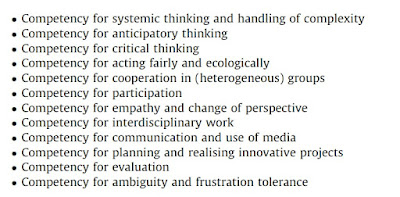We have now reached the end of the course HEDS241, and in this final individual reflection I will look back on what I have learned this semester. I will also look forward, reflecting on how I can use the competences from this course in my own teaching.
- What are the
most important things that you have learnt through your engagement in this
course? Why?
The most important things
I have been introduced to in this course are the critical perspectives on
education, universities, and sustainability education such as for instance
Osberg, D. and Biesta, G. (2020), Lotz-Sisitka et al. (2015), Stein et al (2022),
Orr 1991, It has been a comfort to know that I am not alone in thinking that
the educational system is not doing what it preaches in terms of
sustainability, and that we as educators are not giving students the competence
they need concerning sustainability. For me it is important to acknowledge our
shortcomings and mistakes before we can move on and do something about the
problem.
I also found it very interesting to learn about
all the different views on sustainability (Hopwood et al 2005). This helped me
understand and interpret discussions I have had with others about
sustainability. I also thought it was interesting to read some of the research
concerning sustainability competences, and I especially liked the competence
models that included implementation competency, such as Brundiers et al.,
2021).
The models for sustainability didactics for higher
education was what motivated me to take this course in the first place, and I
did learn a lot about this topic. For instance, I learned that there are
different approaches or teaching styles concerning sustainability education;
normative, fact-based and pluralistic (Öhman and Östman, 2019). The pluralistic
approach treats sustainability questions as political problems, where people
might agree on the facts, but can have different ideas to how to solve the problem.
The pluralistic tradition has been found to be the most promising way
forward.
We also learned about several different
pluralistic didactic models for teaching sustainability, such as Constructive
alignment and Tree of Science (Wilhelm et al., 2019), Wicked problems (Block et
al., 2019), Sustainability commitment (Öhman & Sund, 2021), and finally
Five forms of democratic participation (Lundegård & Caiman, 2019). I
preferred the last one, as it resonates with my own teaching philosophy of
student activity and participation.
· How will your learning influence your practice?
I liked the pluralistic
approach to sustainability education, and especially the the five forms of
democratic participation-model. Without having had a name for it, I think that
my teaching has been moving in this direction for a while. For instance I try
to choose authentic learning situations that give room for student agency and
creativity, as well as giving room for deliberate discussions and critical
reflection. However I still have a lot of work to do here concerning
creating authentic learning situations. I also think I should make the didactic
choices explicit for the students, especially since they are teacher students
and it is important for them to reflect on didactics.
· What are your
thoughts about didactics for sustainability in your
own context?
As a teacher educator, I think that I
have more questions concerning sustainability didactics now, than I had before
the course. Some of the questions I have are; What is the relation between the
didactics in higher education and didactics that teachers use in school? Is it
the same, or different? Do we need a special type of didactics in teacher
education to give teacher students the type of educator competences that they
need to teach their students about sustainability? Or can I teach my teacher
students the Five forms of democratic participation, so that they can use them
with their pupils?
· What are you going to
do as a result of your involvement in this course? Why?
This course has made
me reflect on my own responsibility concerning teaching sustainability. As I
mainly teach chemistry and science didactics for teacher students, I have felt
that sustainability is not really my responsibility. However, some of the readings
we have done for this course has made me rethink this.
 |
| Figure: Chemical hazard symbol for environmental danger. |
Sources:
Block, T., Van Poeck, K.,
& Östman, L. (2019). Tackling wicked problems in teaching and learning.
Sustainability issues as knowledge, ethical and political challenges. In
Sustainable Development Teaching (1st ed., pp. 28–39). Routledge.
https://doi.org/10.4324/9781351124348-3
Brundiers, K., Barth, M.,
Cebrián, G. et al. (2021) Key competencies in sustainability in higher
education—toward an agreed-upon reference framework. Sustain Sci 16,
13–29.
Hopwood, B., Mellor, M.,
and O’Brien, G. (2005). Sustainable development: mapping different
approaches. Sustainable Development, 13(1):38–52.
Lotz-Sisitka, H., Wals, A.
E., Kronlid, D., and McGarry, D. (2015). Transformative, transgressive social
learning: Rethinking higher education pedagogy in times of systemic global
dysfunction.
Lundegård, I., &
Caiman, C. (2019). Didaktik för naturvetenskap och hållbar utveckling - Fem
former av demokratiskt deltagande. Education for science and Sustainable
Development-Five forms of Democratic Participation. Nordic Studies in Science
Education, 15(1), 38-53. (In Swedish)
Orr, D. (1991) What
is education for?
Osberg, D. and Biesta, G.
(2020). Beyond curriculum: Groundwork for a
non-instrumental theory of education. Educational
Philosophy and Theory.
Stein, S., Andreotti, V.,
Susa, R., Ahenakew, C., and Cajková, T. (2022). From
“education for sustainable development” to “education for the end of the world
as we know it” Educational
Philosophy and Theory, 54(3):274–287
Wilhelm, S., Förster, R.,
& Zimmermann, A. B. (2019). Implementing competence
orientation: Towards constructively aligned education for sustainable
development in university-level teaching-and-learning Sustainability,
11(7), 1891.
Öhman, J., & Östman,
L. (2019). Different teaching traditions in environmental and sustainability
education. In Sustainable Development Teaching (pp. 70-82). Routledge.
Öhman, J., & Sund, L.
(2021). A didactic model of sustainability commitment. Sustainability, 13(6),
3083.











